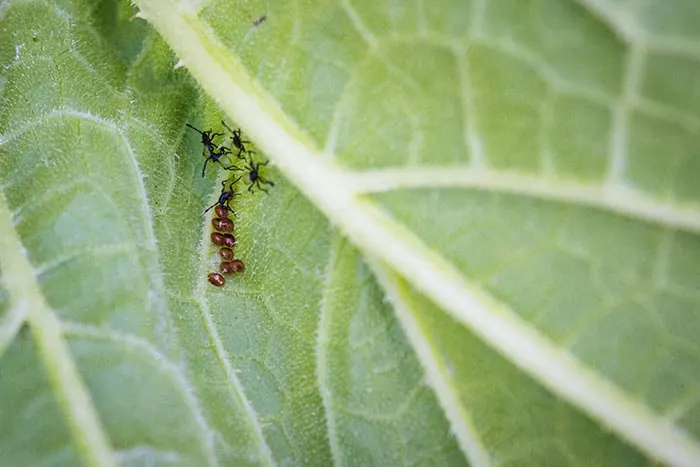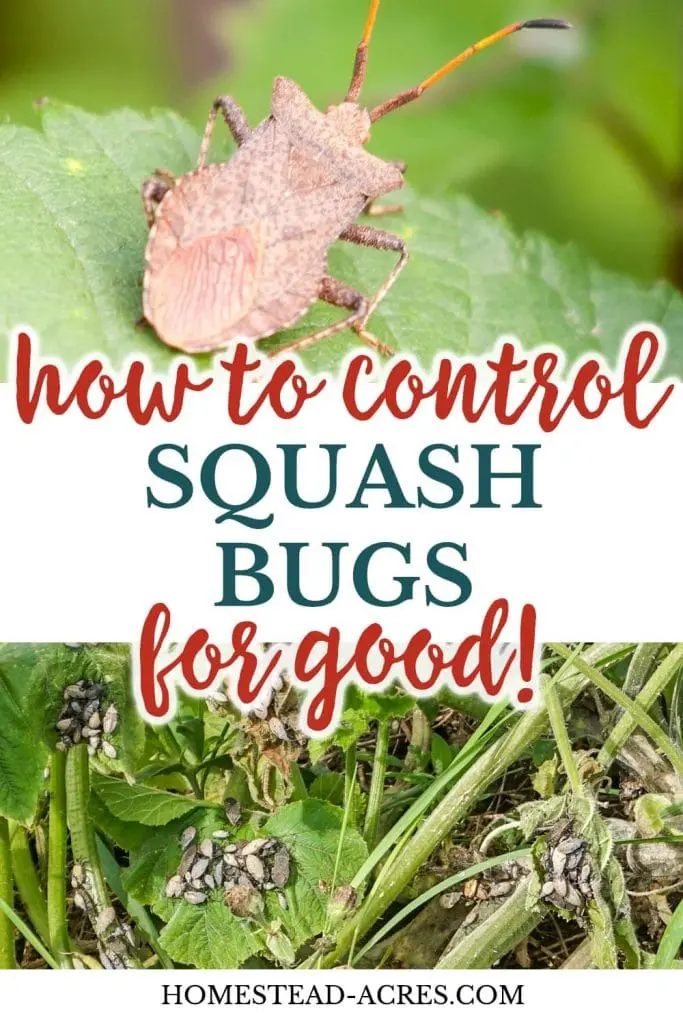This post may contain affiliate links, my full disclosure can be read here. As an Amazon Associate I earn from qualifying purchases.
Squash bugs can be found feeding in large numbers on summer squash, pumpkins, winter squash, and cucumbers. Here’s how to get rid of squash bugs naturally and tips for preventing outbreaks in your garden.
I gardened for 20 years without ever seeing a squash bug and had no idea how lucky I was. After we moved to our current homestead the trouble began.
It was in our second year gardening here that I went out to water our pie pumpkins one day and found they were covered in these tiny grey bugs with black legs.

At the time I didn’t know what they were, although to me they almost looked like a giant aphid I knew it couldn’t be.
It didn’t take long to figure out that we had been infested with squash bugs! Oh my, what damage they can cause to your garden and very quickly too.
I’ve tried many methods of controlling and getting rid of squash bugs over the years and finally came up with ways that really do work.
Are you ready to get these nasty squash killing bugs out of your garden?
What Are Squash Bugs?

Squash bugs drive gardeners crazy! These nasty bugs seem to come out of nowhere and can be difficult to kill.
One day your squash plants are looking lush and healthy, then suddenly they are wilting and dying.
Squash bugs as you may guess from their name are commonly found on squash plants like zucchini but they also will eat pumpkins and cucumbers.
They are often mistaken for stink bugs because they are similar in size and color and both bugs give off a strong odor when squashed.
But if you look closely you’ll find that stink bugs are wider and more round in shape than squash bugs.
How To Identify Squash Bugs
Adult squash bugs are fairly large insects and easy to spot in your garden. The adults are 5/8 inch long (1.58 cm) in size and brownish to grey in color with a flat back.
On the sides and abdomen, they have small orange stripes.
Squash bugs are able to fly but most often you will find them just walking around on the plants. They like to hide on the underside of the leaves and on the stems close to the ground.
Young squash bugs are light grey in color with black legs and move much faster than the adult bugs. You will find them feeding in groups on the undersides of squash leaves.
Squash Bug Lifecycle
Adult

Squash bug adults overwinter in protected areas of your garden. In the late spring as the weather warms they begin to emerge. This is often in June in Canada and the Northern USA.
Eggs

The adult squash bugs begin to feed on squash and cucumber plants, breed and lay their eggs over a 10 day period. The eggs are laid on the underside of the squash leaves, often in a diamond or V-shaped pattern.
They are easy to recognize as they are a coppery red color and look like little metallic balls on the undersides of the leaves. The eggs take 1 to 2 weeks to hatch.
Nymphs
Squash bugs don’t go through a pupal stage, instead, the nymphs hatch from their eggs and grow through instar stages looking more like an adult squash bug with each stage.
When the nymph first hatch they can look very much like an overgrown aphid but are grey in color with black legs.
Squash Bug Plant Damage

What damage do squash bugs do to your plants? Well, a lot!
Both the adults and the nymphs feed on squash plants by piercing the plant with their sharp proboscis (mouth) and injecting toxic saliva into the plant while they suck out the juice.
You will first notice the damage looking like small yellow spots on the leaves that later turn black.
As the feeding gets heavier the leaves will start to wilt eventually looking like a brown and black dead leaf hanging on the end of the stock. The vines will also start to turn black and dry out.
Squash bugs also spread the Cucurbit yellow vine decline (CYVD) which is similar to the bacterial wilt spread by cucumber beetles but kills plants much faster.
Squash plants infected with CYVD will wilt and turn yellow nearly overnight and often about 2 weeks before the fruit is ready to harvest.

How To Get Rid Of Squash Bugs
Dealing with this pest can seem very overwhelming at first, you may be wondering how do you kill squash bugs?
After all, there are many methods out there but squash bugs are hard to kill with chemical methods.
You probably don’t want to use toxic chemicals on your garden anyway right?
1. Removing Squash Bug Eggs
Controlling squash bugs in your garden starts early in the season. The best thing you can do to prevent an outbreak is to start going through your squash plants every few days looking for squash bug eggs.
Turn the leaves over to look for the eggs. Squash bug eggs are small, shiny, oval-shaped and copper-colored.
If you see them squish them or scrape them off into a container of soapy water to dispose of.
2. Dish Soap Spray
After squash bugs hatch the easiest way to kill them naturally is to use dish soap. Out of all the ways to get rid of squash bugs this is my favourite!
It might surprise you but using simple dish soap is a great way to kill many bugs in your garden without using harmful chemicals.
To make your own dish soap squash bug spray take 2 tablespoons of dish soap and mix it with 1 gallon of water in a garden sprayer. Fill the sprayer up with water first before adding the soap.
You want it to mix in not foam up.
Go through your squash plants looking for the nymphs and adults, when you find them spray them well with the soapy water mixture. It kills them very quickly.
3. Duct Tape
Another simple way to get rid of squash bugs is to use duct tape. Cut a length of duct tape and fold it back so the sticky side is facing outwards in a loop around your hand.
Turn the squash plants leaves over and when you see squash bugs touch them with the tape. This is a very easy way to grab a lot of squash bugs off your plants quickly.
4. Diatomaceous Earth
Diatomaceous earth is another natural way of controlling squash bugs it also works very well for cucumber beetles. If you are using this method sprinkle diatomaceous earth around the base of the squash plants.
It only works when it’s dry so remember to reapply after heavy rain.
If you haven’t used it before diatomaceous earth is simply a soft sedimentary rock created from fossilized sea algae called diatoms.
Bugs hate to crawl through this as it feels very sharp to them and will kill the bugs quickly too. Make not to put any on the flowers of your plants as it will harm bees and other insects too.
Just make sure to use food grade diatomaceous earth in your garden. There are versions sold for garden use but they often contain other chemicals and even insect attractants.
How To Prevent Squash Bugs
There are many things you can do to help prevent squash bug damage in your garden.
- Clean your garden in the fall, remove old squash vines and anything squash bugs can use as a shelter for over-wintering.
- Use companion planting to repel squash bugs. Plant tansy and nasturtiums around your squash plants.
- Keep squash plants covered with bug netting until they begin to flower. Squash bugs only produce one generation each year, if you can keep your plants covered in the spring and early summer it will keep them from finding your plants.
- Delay planting until the early summer. If covering your squash plants isn’t an option then try delaying planting until early summer.
- Whenever possible trellis your squash plants. This gives squash bugs fewer places to hide and makes them easier to find and get rid of on your plants.
- Encourage natural predators like parasitic wasps and the Tachinid fly.
Plants Resistant To Squash Bugs
Squash bugs will eat any type of squash but they have favorites. Crooknecks, yellow straight neck, hubbard, and pumpkins are more susceptible to squash bugs.
Try growing varieties of squash that is less attractive like:
- Black Zucchini
- Acorn Squash
- Spaghetti Squash
- Butternut Squash
- Tromboncino
Yes, You Can Beat Squash Bugs!
Squash bugs can be a real nightmare in your vegetable garden. But don’t give up growing your favourite squash!
Start checking early in the season for squash bug eggs and destroy them before they hatch. Attract beneficial insects to your garden. Use natural methods to kill the adults before they cause too much damage.
Homemade Squash Bug Spray
Equipment
- Garden Sprayer
Materials
- 2 Tbs. Dish soap
- 1 gallon water
Instructions
- Fill your container up with water until it’s almost full.
- Add 2 tbs. of dish soap to the sprayer.
- Then finish filling the container up with water.
- Give it a shake to make sure the soap is mixed in with the water.
Notes
Connect With Homestead Acres!
Be sure to follow me on social media, so you never miss a post!
Facebook | Twitter | Pinterest | Twitter
Visit my Amazon store to find all my favorite gardening, homesteading tools, and gadgets plus all of my printed garden books and journals!

Kim Mills is a homeschooling mom of 6 and lives on an urban homestead in Ontario, Canada. Blogging at Homestead Acres she enjoys sharing tips to help you save money, grow and preserve your own food.





Bonnie
Thursday 15th of February 2024
Been gardening for years and years, owned a nursery for 15 years. The best thing I have ever used is home defense. We can not always be organic if we want to save our gardens. Home defense was all it took and they never came back.
Jeray
Wednesday 9th of August 2023
I appreciate your advice. I am new to all of this. My pumpkins were being destroyed. However, the spaying of the soapy water has destroyed now my watermelon leaves. They are dead now. I do t think I will ever do that again. I’m so sad. I guess I learned a lot this year.
Virginia
Tuesday 21st of February 2023
Clarifying question--When you say dish soap, are you talking about actual soap or dishwashing detergent?
tony martin
Friday 26th of August 2022
Hope you can help me out,I was just out in my garden and my squash plants were covered with bugs.I made up some spray and heading out soon, my question is should i bag or burn the plants i cant save or will it be ok for me to put in compost.(going to try trench composting this fall first time ) hope you can lead me in the right direction. thank you tony
William Jennings
Thursday 4th of August 2022
Dish soap has chemicals also. Is there a certain brand to use that will work and doesn’t have chemicals in it?